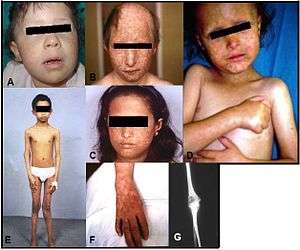Poikiloderma
Poikiloderma is a skin condition that consists of areas of hypopigmentation, hyperpigmentation, telangiectasias and atrophy. Poikiloderma of Civatte is most frequently seen on the chest or the neck, characterized by red colored pigment on the skin that is commonly associated with sun damage.[1]
| Poikiloderma | |
|---|---|
 | |
| People with varying manifestations of poikiloderma | |
| Specialty | Dermatology |
Causes
- Congenital
- Rothmund-Thompson syndrome
- Dyskeratosis congenita
- Mendes da Costa syndrome
- Other hereditary causes
- Degos-Touraine syndrome
- Diffuse and macular atrophic dermatosis
- Hereditary sclerosing poikiloderma of weary
- Kindler syndrome
- Weary-Kindler syndrome
- Xeroderma pigmentosum
- Acquired
- Injury to cold, heat, ionizing radiation, exposure to sensitizing chemicals
- Lichen planus
- Dermatomyositis
- Lupus erythematosus
- Systemic sclerosis
- Cutaneous T cell lymphomas
Pathogenesis
The exact cause of poikiloderma of Civatte is unknown; however, extended sun exposure, namely the ultraviolet light emitted by the sun, is the primary factor.[2]
Diagnosis
Treatment
Albeit difficult, treatment of poikiloderma of Civatte involves the delivery of multiple wavelengths of intense pulsed light (IPL) to the affected area.[3]
gollark: > shut the fuck up until you're an adult<:bees:724389994663247974>
gollark: Give your turtlebot crafting stuff.
gollark: Disk drive + floppy disk.
gollark: Yep!
gollark: PotatOS has skynet integrated.
See also
- Osteopoikilosis
- List of cutaneous conditions
References
- Raulin, Christian; Karsai, Syrus (2011). Laser and IPL Technology in Dermatology and Aesthetic Medicine. Springer Science & Business Media. p. 236. ISBN 9783642034381. Retrieved 7 March 2018.
- American Osteopathic College of Dermatology "Dermatologic Disease Database", aocd.org, referenced July 22, 2011.
- PubMed.gov "Treatment of poikiloderma of Civatte with an intense pulsed light source", PubMed.gov, referenced July 22, 2011.
This article is issued from Wikipedia. The text is licensed under Creative Commons - Attribution - Sharealike. Additional terms may apply for the media files.